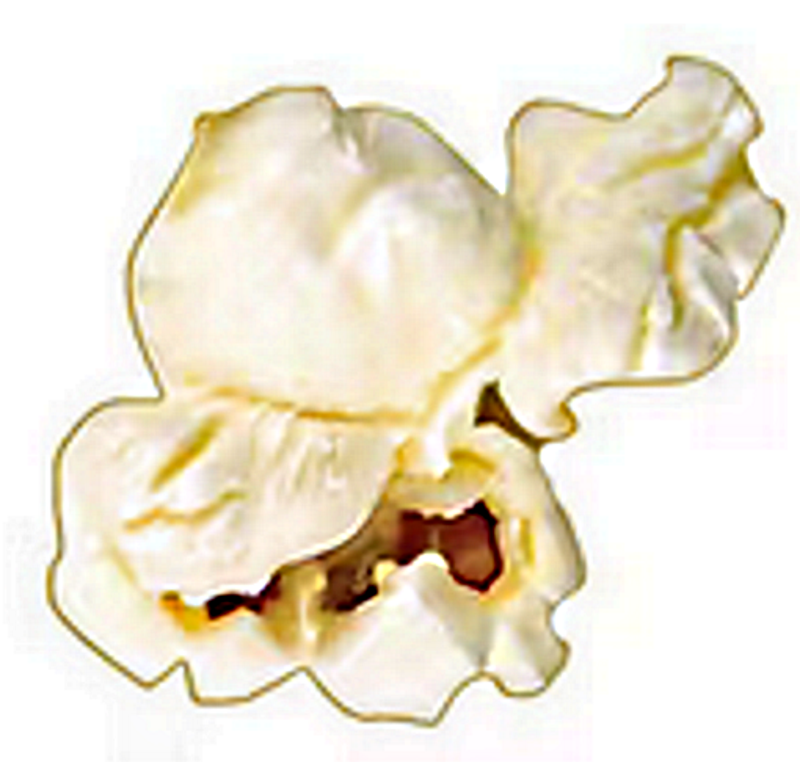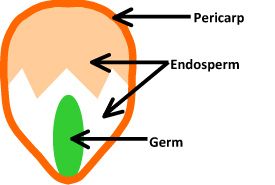Post by 1dave on Jul 18, 2023 13:12:37 GMT -5
How does THIS


Change into THIS?

Or THIS?

It is because of THIS!

Starch and water. When Popcorn is harvested in the fall, the kernels’ moisture content is between 16 and 20%. The kernels are then dried reaching an optimum moisture level of 14%. If the moisture content drops below that value, the size of the popped kernels is smaller and the number of kernels that pop decreases. If above that value the steam explosions will blow them apart.
Each kernel contains two kinds of starch held together by strong Pi Bonds encased in a strong outer shell capable of containing pressures up to 135 pounds per square inch! When the popcorn reaches a temperature of 180 C (356 F), the pressure inside the kernel is sufficient to rupture the popcorn hull, essentially turning the kernel inside-out.
BUT the Pi bonds are strong enough to hold the starch together.
www.thoughtco.com/how-does-popcorn-pop-607429
Science, Tech, Math › Science
How Popcorn Pops
An overflowing bowl of popcorn
Dana Hoff/Getty Images
By Anne Marie Helmenstine, Ph.D.
Anne Marie Helmenstine, Ph.D.
Chemistry Expert
Ph.D., Biomedical Sciences, University of Tennessee at Knoxville
B.A., Physics and Mathematics, Hastings College
Dr. Helmenstine holds a Ph.D. in biomedical sciences and is a science writer, educator, and consultant. She has taught science courses at the high school, college, and graduate levels.
Learn about our Editorial Process
Updated on August 07, 2019
Popcorn has been a popular snack for thousands of years. Remnants of the tasty treat have been found in Mexico dating back to 3600 BC. Popcorn pops because each popcorn kernel is special. Here's a look at what makes popcorn different from other seeds and how popcorn pops.
Why It Pops
Popcorn kernels contain oil and water with starch, surrounded by a hard and strong outer coating. When popcorn is heated, the water inside the kernel tries to expand into steam, but it cannot escape through the seed coat (the popcorn hull or pericarp). The hot oil and steam gelatinizes the starch inside the popcorn kernel, making it softer and more pliable.
When the popcorn reaches a temperature of 180 C (356 F), the pressure inside the kernel is around 135 psi (930 kPa), which is sufficient pressure to rupture the popcorn hull, essentially turning the kernel inside-out. The pressure inside the kernel is released very quickly, expanding the proteins and starch inside the popcorn kernel into a foam, which cools and sets into the familiar popcorn puff. A popped piece of corn is about 20 to 50 times larger than the original kernel.
If popcorn is heated too slowly, it won't pop because steam leaks out of the tender tip of the kernel. If popcorn is heated too quickly, it will pop, but the center of each kernel will be hard because the starch hasn't had time to gelatinize and form a foam.
How Microwave Popcorn Works
Originally, popcorn was made by directly heating the kernels. Bags of microwave popcorn are a bit different because the energy comes from microwaves rather than infrared radiation. The energy from the microwaves makes the water molecules in each kernel move faster, exerting more pressure on the hull until the kernel explodes. The bag that microwave popcorn comes in helps trap the steam and moisture so the corn can pop more quickly. Each bag is lined with flavors so when a kernel pops, it strikes the side of the bag and gets coated. Some microwave popcorn presents a health risk not encountered with regular popcorn because the flavorings are also affected by the microwave and get into the air.
Does all corn pop?
Popcorn that you buy at the store or grow as popcorn for a garden is a special variety of corn. The commonly cultivated strain is Zea mays everta, which is a type of flint corn. Some wild or heritage strains of corn will also pop. The most common types of popcorn have white or yellow pearl-type kernels, although white, yellow, mauve, red, purple, and variegated colors are available in both pearl and rice shapes. Even the right strain of corn won't pop unless its moisture content has a moisture content around 14 to 15%. Freshly harvested corn pops, but the resulting popcorn will be chewy and dense.
Sweet Corn and Field Corn
Two other common types of corn are sweet corn and field corn. If these types of corn are dried so they have the right moisture content, a small number of kernels will pop. However, the corn that pops won't be as fluffy as regular popcorn and will have a different flavor. Attempting to pop field corn using oil is more likely to produce a snack more like Corn Nuts, where the corn kernels expand but don't break apart.
Do other grains pop?
Popcorn is not the only grain that pops! Sorghum, quinoa, millet, and amaranth grain all puff up when heated as the pressure from expanding steam breaks open the seed coat.
ThoughtCo is part of the Dotdash Meredith publishing family.
Please review our updated Terms of Service.
knowledge.carolina.com/discipline/physical-science/the-science-of-popcorn/
Carolina Knowledge Center
ChemistryChemistry & Physics
The Science of Popcorn

Figure 1
Introduction
Popcorn is one of the world’s favorite snack foods. In the US, Americans consume as much as 18 billion quarts of popcorn each year, which equates to 56 quarts per person. Some nutritionists call it a perfect snack food because it is a whole grain, a good source of fiber, and low in fat. One study even claims there are more antioxidants in popcorn than in some fruits and vegetables.1
Background
The most intriguing part of popcorn is the science behind how it pops. Popcorn is the only grain in the corn family that pops open when exposed to temperatures above 180° C. A popcorn kernel is composed of 3 parts: the pericarp, germ, and endosperm. See Fig. 1.
The pericarp is the tough outer shell surrounding a popcorn kernel, and the key to what makes it pop. Inside the pericarp is the germ, or seed embryo. Adjacent to the germ is the endosperm, which contains some trapped water plus soft and hard starch granules that serve as food for the germ when it sprouts.
When a popcorn kernel is heated, the trapped water in the endosperm turns into steam, building up pressure inside the pericarp. This pressurized, super-heated steam transforms the soft starch in the endosperm into a gelatinous material. Popcorn pericarp is much stronger than that of all other corn kernels and is able to retain this pressurized steam up to 9.2 atm (135 psi).
Above that pressure, the pericarp ruptures, releasing the steam and gelatinous starch that solidifies upon cooling. The resulting popped kernel is 40 to 50 times its original size.
Figure 1 – Corn kernel
People often wonder what is the ideal percentage of water in popcorn kernels for best popping. Popcorn is harvested in the fall when the kernels’ moisture content is between 16 and 20%. The kernels are then stored in bins where they are dried by forced air until reaching an optimum moisture level of 14%. If the moisture content drops below that value, the size of the popped kernels is smaller and the number of kernels that pop decreases.











